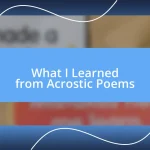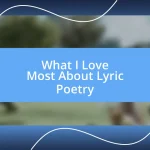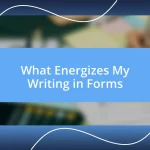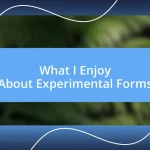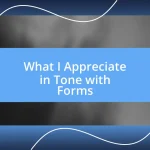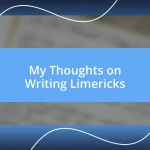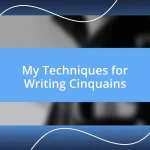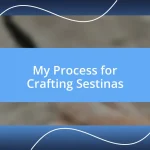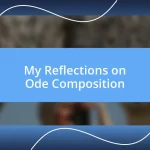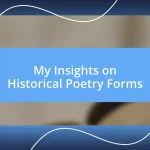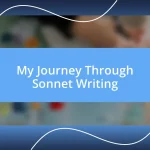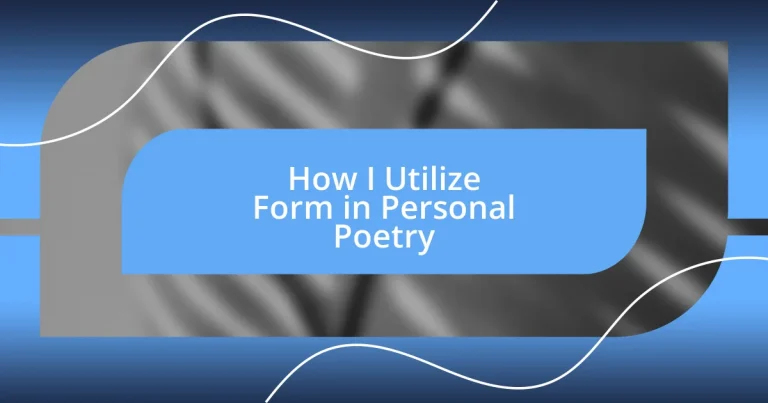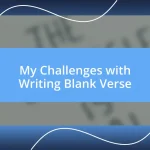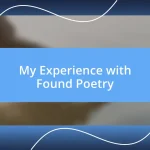Key takeaways:
- Different poetic forms, such as sonnets and haikus, each offer unique structures that can enhance emotional expression and creativity.
- Techniques like meter, rhyme schemes, and enjambment are essential for crafting structured poetry, allowing the writer to convey feelings more effectively.
- Finding a balance between form and personal voice can transform constraints into opportunities for deeper self-expression in poetry.
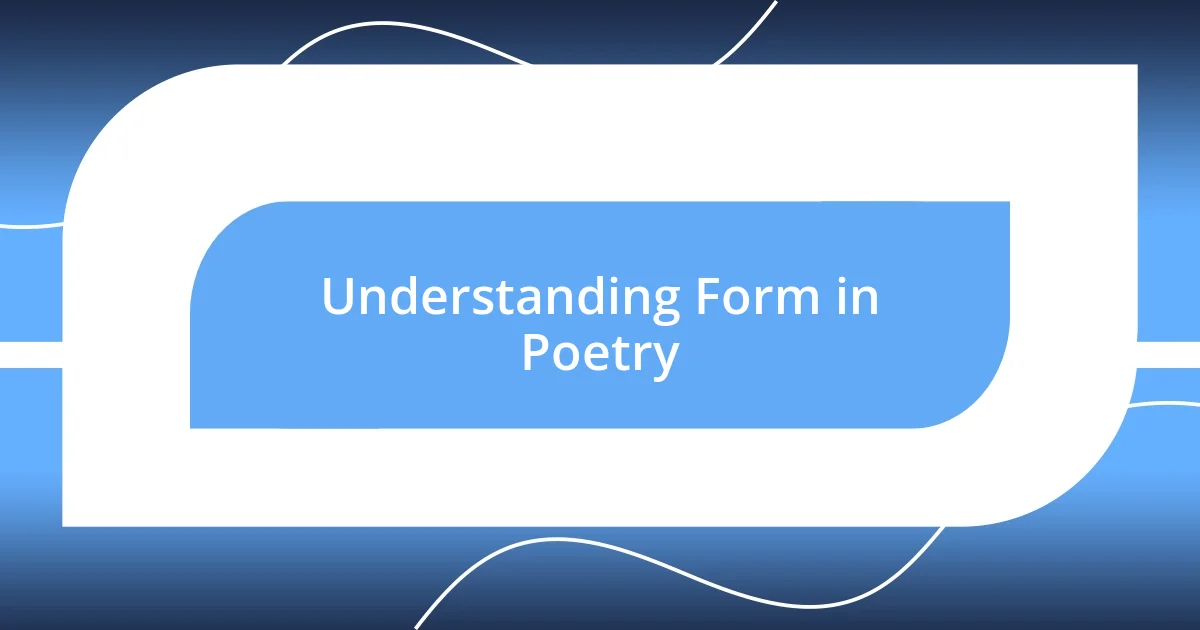
Understanding Form in Poetry
Form in poetry is like the framework of a house; it supports and shapes the experience of the reader. I remember the first time I encountered a sonnet—its rigid structure seemed daunting at first. But as I engaged with its rhythm and rhyme, I realized that those constraints allowed my thoughts to flow more freely, encouraging creativity within boundaries.
When I think about free verse, I feel a different kind of liberation. There are no rules to bind the words, which can be exhilarating but sometimes overwhelming. Have you ever let yourself write without a plan? I find that this lack of structure can lead me to deeper, more personal insights—moments I might not capture in tighter forms.
Exploring different forms often helps me tap into my emotions more powerfully. For instance, when I was feeling particularly vulnerable, writing in a haiku forced me to distill my feelings into just a few syllables. It taught me that sometimes, the most profound expressions come from simplicity. How has exploring form influenced your own writing journey?
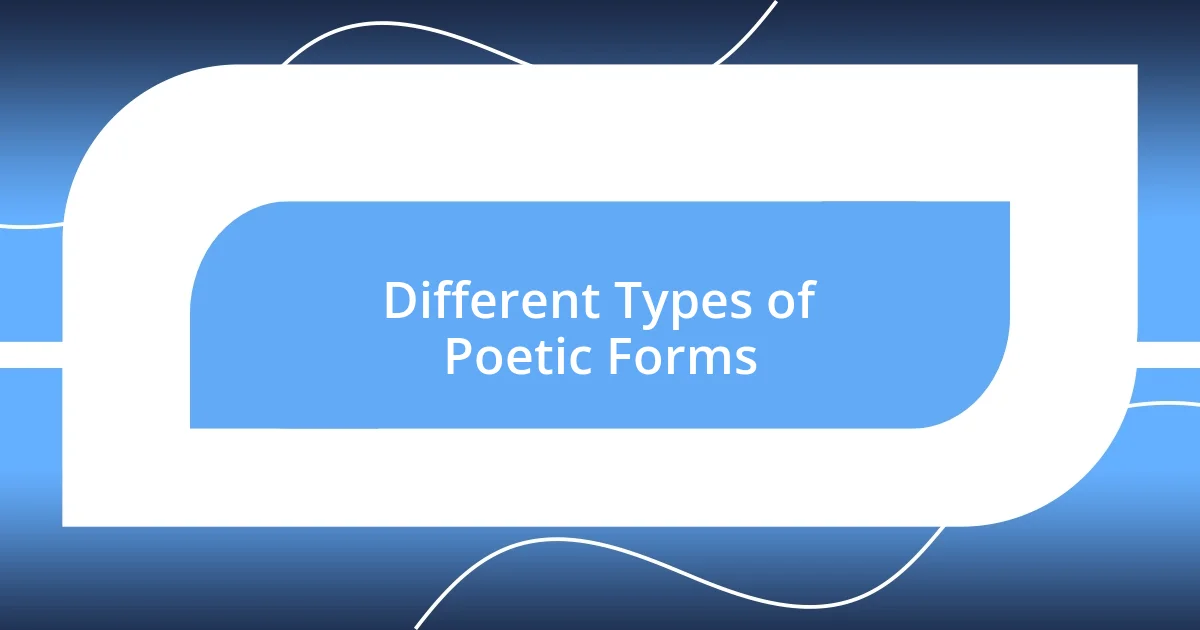
Different Types of Poetic Forms
Different poetic forms each offer unique ways to express emotions and ideas. For example, I often find myself drawn to the villanelle, with its intricate rhyme scheme and repetitive lines. Writing a villanelle can feel like a dance, moving my thoughts in circles that build on each other. There’s something deeply satisfying in how the refrains tie the piece together, creating a compelling emotional crescendo.
Here are some popular poetic forms I love exploring:
- Haiku: A three-line poem with a 5-7-5 syllable structure, capturing fleeting moments.
- Sonnet: A 14-line poem, often divided into sections; it invites deep reflections on love and life.
- Free Verse: No strict rules; this form allows for spontaneous expression of thoughts and feelings.
- Limerick: A whimsical five-line form that often brings humor and lightness to serious themes.
- Ode: A lyrical poem expressing deep emotion, often dedicated to someone or something inspiring.
Each form has its own charm and nuances, and I enjoy experimenting with them to discover new depths in my writing. Some days, I might feel the constraints of a sonnet spark a deeper emotional response, while on others, a haiku’s simplicity helps me focus my thoughts in an unexpected way. It’s a journey of exploration, and I relish every moment spent navigating these diverse landscapes of language.
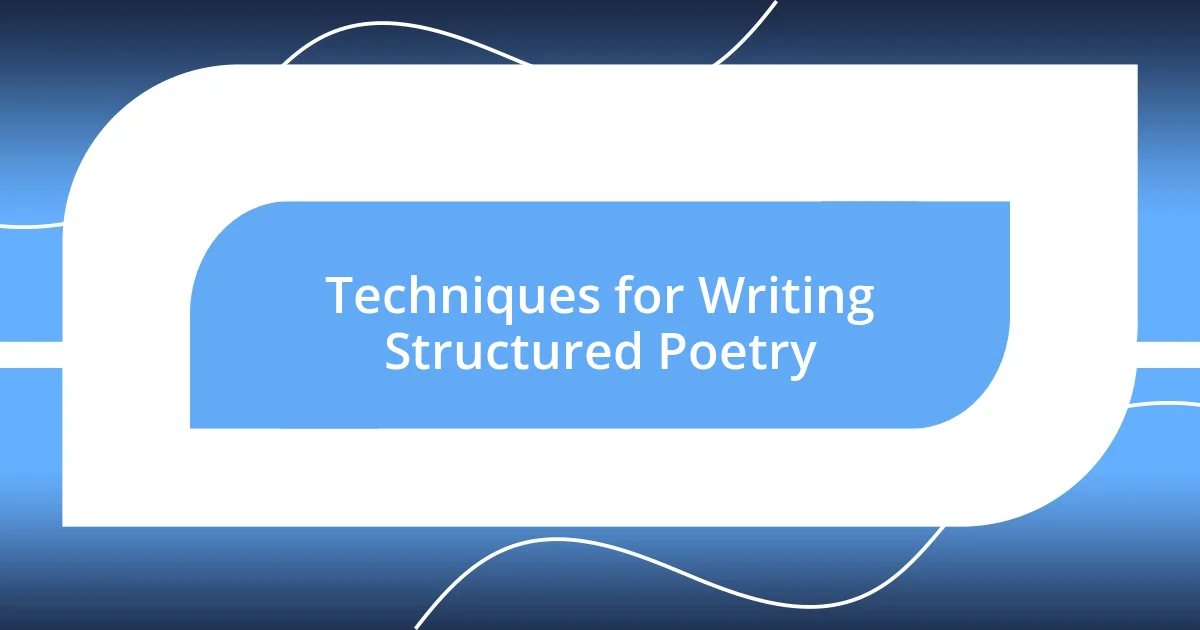
Techniques for Writing Structured Poetry
When I write structured poetry, techniques like meter and rhyme schemes become my trusty companions. For instance, I remember working on an English sonnet for a workshop, carefully counting syllables as I constructed each line. The rhythm of iambic pentameter not only shaped my words but also my emotions; it felt like my heart was beating in tandem with the poem. What about you—have you ever felt your writing influence your emotional state?
Another technique I find essential is the use of enjambment—the ability to carry lines over to the next without a pause. This reinforces the sense of motion and urgency in my poetry. Once, while writing a series of couplets about time, I let the lines spill over, and it created a beautiful flow that felt like a stream, reflecting the relentless passage of moments. It reminded me of how life often moves, sometimes without warning or a chance to breathe.
Lastly, I can’t forget the power of imagery in structured forms. In writing a villanelle about longing, I utilized vivid images that repeated, evoking a sense of nostalgia. Every descriptive line seemed to deepen the emotional impact, wrapping the reader in layers of feeling. Have you found imagery to be a potent tool in your own poetry? It opens doors to places within ourselves we might not explore without a chosen form.
| Technique | Description |
|---|---|
| Meter | Establishes rhythm, guiding the reader’s experience. |
| Rhyme Scheme | Creates musicality that enhances the emotional resonance. |
| Enjambment | Encourages flow, drawing readers into the unfolding narrative. |
| Imagery | Evokes senses, painting a vivid picture that deepens connection. |
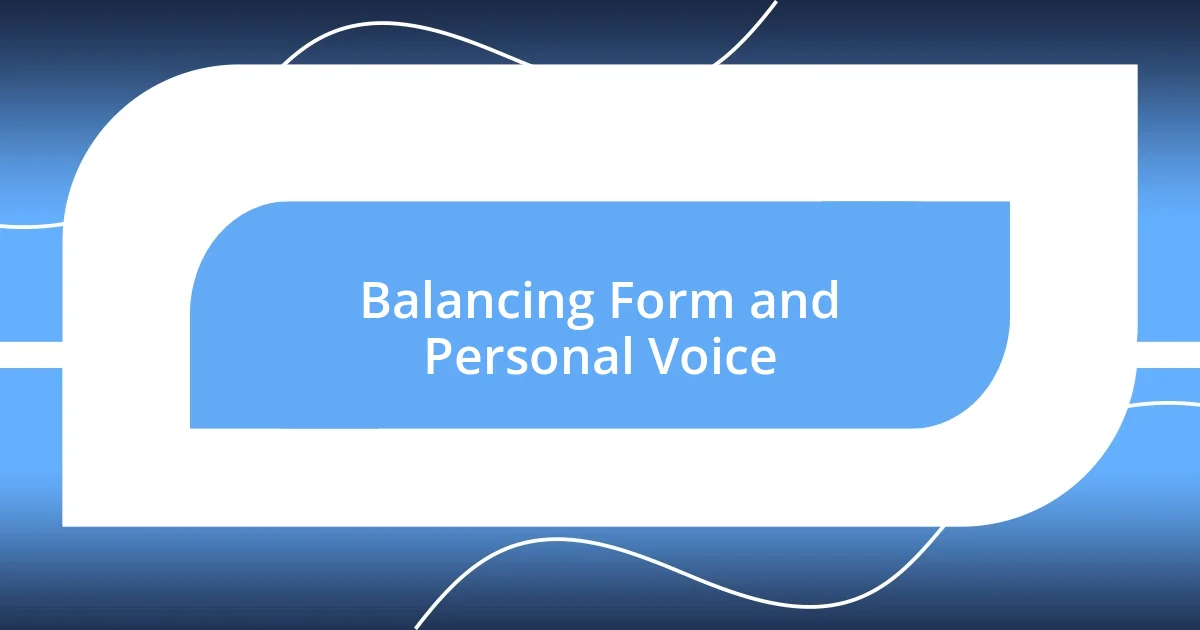
Balancing Form and Personal Voice
Finding the right equilibrium between form and my personal voice is like walking a tightrope. I remember penning a couplet that felt stifled by its own structure, yet through a twist in the rhyme, my voice began to emerge. Have you ever felt a form trying to box you in, only to discover that with a slight shift, it can become a canvas for your true self?
Sometimes, I embrace the constraints of a specific form, understanding that limitations can spark creativity rather than hinder it. While writing a haiku about a fleeting summer evening, the syllable count forced me to distill my emotions into just a few words. The simple elegance of the haiku created space for my voice to shine through the imagery, transforming something ordinary into something profoundly beautiful. How often do we overlook the power of simplicity in our rush to express complex feelings?
In moments when I prioritize my personal voice, the form feels more like a guide than a restriction. Recently, I experimented with a free verse poem about loss, allowing my thoughts to flow unencumbered. The absence of a predetermined structure gave me the freedom to explore raw emotions. I found that in such freedom, my voice resonated stronger—it’s like stripping away layers to reveal the core of what I truly want to say. Isn’t that the essence of poetry? Finding that sweet spot where structure and self meet, creating something uniquely resonant.
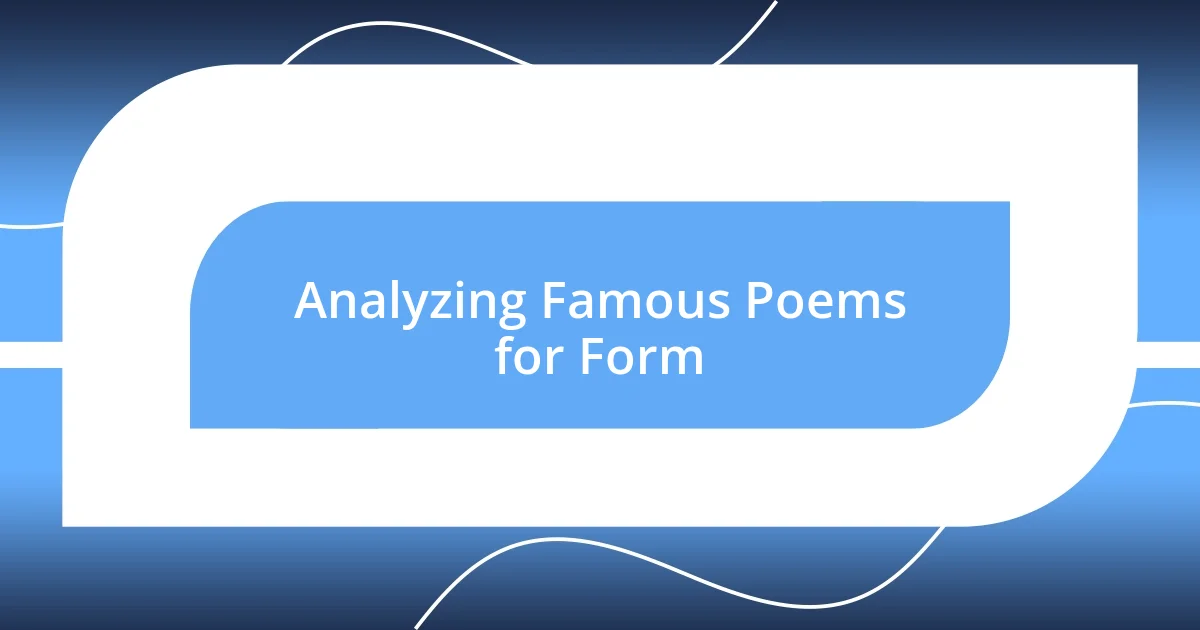
Analyzing Famous Poems for Form
When I dive into the world of famous poems, I often find myself captivated by how structured forms can guide the expression of profound themes. Take for instance Robert Frost’s “The Road Not Taken.” The poem’s ABAAB rhyme scheme not only creates a musical quality but also emphasizes the tension and contrast embedded in the choices we face. I remember feeling that same weight when I was choosing between two paths in my life, and Frost’s rhythmic cadence mirrored my internal struggle perfectly. Can you think of a poem that resonated with your own life choices?
Another powerful example is Emily Dickinson’s use of slant rhyme and unconventional capitalization in poems like “Hope is the thing with feathers.” Her choices infuse meaning into every line and transform simple imagery into complex emotional landscapes. When I explored slant rhymes in my own poetry, I experienced a thrilling realization: breaking away from perfect rhymes can actually deepen the emotional impact, much like Dickinson’s work does. Have you ever experimented with rhyme in ways you didn’t expect to find resonating?
Looking at the structured forms of Shakespeare’s sonnets, one can’t help but admire how the volta—the shift in argument or theme—adds emotional depth. Writing my own sonnet, I was inspired by this technique, noticing how my thoughts shifted halfway through the piece. In that moment, I understood how each line built upon the last, creating a crescendo of feeling. This realization made me wonder: how can a simple turn in thought transform the essence of a poem? It’s fascinating to see how analyzing the structure of these famous works can enhance my own poetic journey.
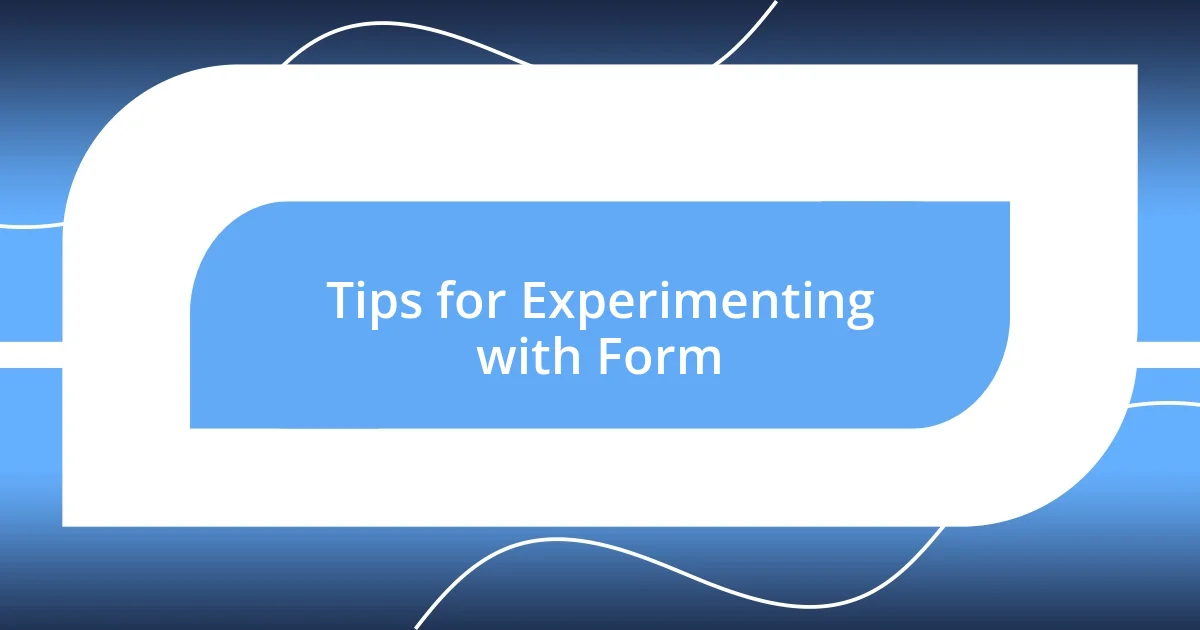
Tips for Experimenting with Form
Experimenting with form can be an exhilarating journey. I remember the first time I tried a sonnet; the rigid structure felt daunting but also incredibly freeing. As I worked through each line, I found joy in the challenge—how manipulating meter and rhyme turned my thoughts into a dance rather than a box. Have you ever faced a similar challenge and emerged stronger for it?
Another approach I enjoy is marrying different forms to create a unique piece. I recently blended a villanelle’s repetition with the fluidity of free verse. The outcome was unexpectedly poignant, as the weight of the repeated lines amplified my emotions, fostering an intimate connection with the reader. What forms have you considered blending to elevate your writing?
Don’t shy away from playfulness! I often write limericks just for fun, letting whimsy guide the content. This lighthearted exploration helps to dispel any pressure I might feel while writing more serious pieces. It’s a reminder that poetry can be a playground for creativity, inviting us to embrace spontaneity without the fear of judgment. Have you allowed yourself the freedom to play with words in such an uninhibited way?
